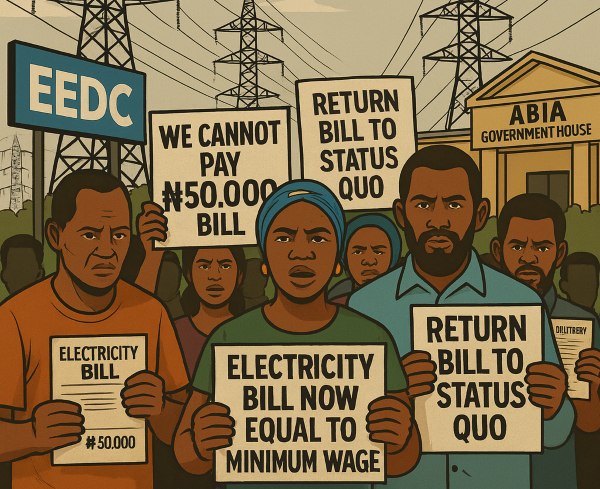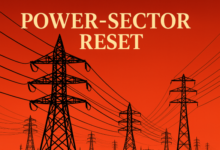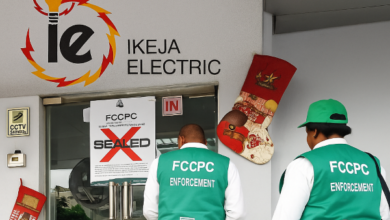Electricity Shock: Umuahia Residents Revolt Over Soaring Electricity Bills

As tariff jumps from ₦53 to ₦200 per kWh, residents demand fairness, transparency, and accountability from EEDC and regulators
The rising cost of living in Nigeria has found yet another flashpoint — this time in Umuahia, the Abia State capital — where angry residents have taken to the streets to protest what they describe as “outrageous, unbearable and unjustified electricity bills” from the Enugu Electricity Distribution Company (EEDC).
In scenes reminiscent of the wider discontent over energy costs sweeping across the nation, the Concerned Umuahia Residents, a coalition of civil servants, artisans, and small business owners, marched peacefully from the EEDC office on Bende Road to the Abia State Government House, voicing deep frustration over skyrocketing power tariffs and erratic supply despite the prohibitive Umuahia electricity bills.
Their placards spoke volumes:
“We cannot pay ₦50,000 bill,”
“Return electricity bill to status quo,”
and “Electricity bill now equals minimum wage.”
The People’s Outcry: When Power Becomes a Burden
According to the group’s leader, Mr. Chukwuemeka Ozugbo, most residents who previously paid between ₦8,000 and ₦12,000 monthly now receive electricity bills ranging between ₦50,000 and ₦70,000 — a staggering 500% increase — despite no improvement in power supply.
“How can a civil servant earning ₦70,000 be asked to pay ₦50,000 for electricity? It’s unjust, unsustainable, and an insult to our collective sense of fairness,” Ozugbo lamented.
For many households, this new set of Umuahia electricity bills is not merely an economic inconvenience but an existential crisis. Families are forced to ration power usage, small businesses struggle to remain open, and some have reverted to generators or kerosene stoves — ironically undermining Nigeria’s clean energy transition goals.
Mr. Nnamdi Okenwa, another protester, said he used to spend about ₦3,000 monthly on prepaid electricity units but now spends as much as ₦17,000 — even with limited consumption.
“EEDC brings power briefly when they want to disconnect or collect payments,” he said. “Once people pay, they return to load shedding. It’s exploitative.”
Behind the Tariff Spike: Band A Controversy and Regulatory Disconnect
The heart of the matter lies in the reclassification of Umuahia’s electricity feeder to Band A — a category meant for consumers guaranteed at least 20 hours of electricity daily.
Under the new structure approved by the Nigerian Electricity Regulatory Commission (NERC), Band A customers are billed about ₦200 per kilowatt-hour, up from ₦53 — a nearly fourfold increase.
However, protesters say the promised 20-hour supply does not exist in reality. Instead, many areas experience less than 10 hours of electricity daily, with long blackouts still common.
“The upgrade to Band A is supposed to reflect improved service. But we are paying more for less power,” Ozugbo said.
The EEDC Head of Commercial Operations, Mr. Festus Iwuala, defended the change, explaining that the tariff adjustment was not arbitrary but based on NERC’s approval.
“The affected feeder was reclassified from Bands B and C to Band A following national regulatory approval,” he said. “We operate strictly within approved frameworks and do not independently set tariffs.”
Nonetheless, industry observers argue that EEDC’s service quality has not met Band A standards, raising ethical and regulatory questions about consumer protection and data transparency.
Government Response: Abia Promises Dialogue, Metering, and Regulation
Responding to the protests, the Abia State Commissioner for Power and Public Utilities, Mr. Ikechukwu Monday, met the demonstrators at the Government House gate and assured them of prompt intervention.
“Your grievances will be addressed through structured dialogue. We commend your peaceful conduct,” he said.
He explained that the tariff jump was tied to the feeder’s reclassification and urged residents to submit formal complaint letters to aid official documentation and resolution.
Monday also highlighted the government’s ongoing reforms, including the Abia State Electricity Law, signed in March 2025, which established the Abia State Electricity Regulatory Authority (ASERA).
Once the transfer of regulatory control from NERC to ASERA is completed by December 2025, the state will have greater autonomy over tariff regulation, distribution oversight, and consumer protection.
“We are committed to achieving full metering across Abia. Over 60,000 meters have been deployed to ensure accurate billing and eliminate estimated charges,” Monday said.
He added that the State Government’s energy modernization efforts would prioritize transparency, fairness, and the protection of low-income households.
The Larger Picture: A National Power Paradox
The Umuahia protest is not an isolated incident but a microcosm of Nigeria’s energy dilemma — where reforms designed to improve efficiency often deepen inequality.
While the Federal Government pushes for cost-reflective tariffs to sustain the power sector, the harsh economic realities of inflation, unemployment, and stagnant wages make such increases politically sensitive and socially volatile.
Analysts warn that without synchronized policy alignment between federal regulators, state governments, and distribution companies (DisCos), the nation risks alienating consumers and eroding public trust in the power reform agenda.
According to BRANDECONOMY’s energy desk analysis, over 60% of Nigerian households still lack reliable access to electricity. Yet, the country’s energy tariffs have risen faster than service quality, making power affordability a major obstacle to industrial growth and household welfare.
Metering, Accountability, and the Future of Power Reform
The Abia government’s commitment to metering aligns with Nigeria’s broader push for transparency in the power sector. However, experts insist that true reform will require:
- Decentralized power governance: Allowing states like Abia to manage local electricity distribution.
- Performance-based tariffs: Linking billing to actual service delivery metrics.
- Digital metering and customer data platforms: To ensure real-time monitoring and eliminate overbilling.
- Consumer inclusion: Engaging communities in decision-making to restore public trust.
Until these measures are fully institutionalized, episodes like Umuahia’s protest will continue to punctuate Nigeria’s energy reform narrative.
Conclusion: Fair Power Pricing or Public Resistance?
The Umuahia protest underlines a fundamental truth — energy reform cannot thrive without fairness. Nigerians are willing to pay for reliable electricity, but they demand transparency, accountability, and measurable service improvement in return.
As Abia sets up its regulatory framework, the EEDC, NERC, and ASERA must align in purpose — not just in policy.
For now, the people of Umuahia wait… for dialogue, justice, and light that truly brightens homes, not just bills.











